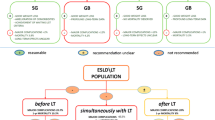Abstract
The influence of body mass index (BMI) on outcome of simultaneous pancreas-kidney transplantation (SPK) has not been well described. We retrospectively reviewed 88 consecutive primary SPKs performed at our institution between March 15, 1995 and August 28, 2001. All patients received antibody induction and maintenance immunosuppression with tacrolimus, mycophenolate mofetil, and steroids. Systemicenteric implantation was performed in all patients. Primary end points were patient, pancreas, and kidney survival. Secondary end points were rates of anastomotic leakage, pancreas thrombosis, major infection, rejection, repeat laparotomy, and length of hospital stay. Values are shown as mean ± standard deviation, range, or percentage. Fifty-two patients (59.1%) were nonobese with a BMI ≦24.9 (mean 21.7 ± 2.2, range 15.4 to 24.9). Thirty-six patients were mild to moderately obese with a BMI ≧25 (mean 27.7 ± 2.2, range 25 to 35.1). Distribution of recipient age, sex, and ethnicity was similar between groups. Kidney and pancreas preservation times were similar between nonobese and obese patients. One-, three-, and five-year actuarial patient (nonobese: 95%, 95%, 95% vs. obese: 95%, 95%, 89%), kidney graft (nonobese: 91%, 91%, 87% vs. obese: 97%, 91%, 85%), and pancreas graft (nonobese: 78%, 78%, 73% vs. obese: 70%, 62%, 62%) survival were comparable between nonobese and obese (P = NS). The mean rates of pancreas thrombosis, major infection, pancreas rejection, kidney rejection, relaparotomy, and length of hospital stay were similar in the two groups. The overall duodenojejunal anastomotic leakage rate was 8%. Obese patients had a 17% incidence of leakage (6 of 36) compared to a 2% incidence of leakage in nonobese patients (P = 0.012). Six of seven leaks occurred in obese patients. Mean BMI in the seven patients with a leak (27 ± 1.9) was significantly higher than in patients who did not develop a leak (24 ± 3.7; P = 0.05). Although obesity had no effect on patient or graft survival, it was associated with a significantly higher leakage rate. There should therefore be a higher degree of suspicion for the presence of duodenojejunal anastomotic leaks in obese SPK recipients.
Similar content being viewed by others
References
Calle EE, Thun MJ, Petrelli JM, Rodriguez C, Heath CW Jr. Body mass index and mortality in a prospective cohort of U.S. adults. N Engl J Med 1999;341:1097–1105.
Pemberton LB, Manax WG. Relationship of obesity to postoperative complications after cholecystectomy. Am J Surg 1971;121:87–90.
Postlethwait RW, Johnson WD. Complications following surgery for duodenal ulcer in obese patients. Arch Surg 1972;105:438–440.
Strauss RJ, Wise L. Operative risks of obesity. Surg Gynecol Obstet 1978;146:286–291.
Holley JL, Shapiro R, Lopatin WB, et al. Obesity as a risk factor following cadaveric renal transplantation. Transplantation 1990;49:387–389.
Gill IS, Hodge EE, Novick AC, et al. Impact of obesity on renal transplantation. Transplant Proc 1993;25:1047–1048.
Modlin CS, Flechner SM, Goormastic M, Goldfarb DA, Papajcik D, Mastroianni B, Novick AC. Should obese patients lose weight before receiving a kidney transplant? Transplantation 1997;64:599–604.
Pirsch JD, Armbrust MJ, Knechtle SJ, et al. Obesity as a risk factor following renal transplantation. Transplantation 1995; 59:631–647.
Feldman HI, Faxio I, Roth D, et al. Recipient body size and cadaveric renal allograft survival. J Am Soc Nephrol 1996; 7:151–157.
Meier-Kriesche HU, Varghela M, Thambuganipalle R, et al. The effect of body mass index on long-term renal allograft survival. Transplantation 1999;68:1294–1297.
Blumke M, Keller E, Eble F, et al. Obesity in kidney transplant recipients as a risk factor. Transplant Proc 1993;25:2618.
Merion RM, Twork AM, Rosenberg L, et al. Obesity and renal transplantation. Surg Gynecol Obstet 1991;172:367–376.
Johnson DW, Isbel NM, Brown AM, et al. The effect of obesity on renal transplant outcome. Transplantation 2002; 74:675–681.
Howard RJ, Thai VB, Patton PR, et al. Obesity does not portend a bad outcome for kidney transplant recipients. Transplantation 2002;73:53–55.
Meier-Kriesche HU, Arndorfer JA, Kaplan B. The impact of body mass index on renal transplant outcomes: A significant independent risk factor for graft failure and patient death. Transplantation 2002;73:70–74.
Bumgardner GL, Henry ML, Elkhammas E, et al. Obesity as a risk factor after combined pancreas/kidney transplantation. Transplantation 1995;60:1426–1430.
Hubert HB, Feinleib M, McNamama PM, Castelli WP. Obesity as an independent risk factor for cardiovascular disease: A 26 year follow-up of participants in the Framingham Heart Study. Circulation 1983;67:968–977.
Walker SP, Rimm EB, Ascherio A, et al. Body size and fat distribution as predictors of stroke among US men. Am J Epidemiol 1996;144:1143–1150.
Odorico JS, Sollinger HW. Technical and immunosuppressive advances in transplantation for insulin-dependent diabetes mellitus. World J Surg, 2002;26:1784–1791.
International Pancreas Transplant Registry, 199 Annual Report (University of Minnesota).
Koyama H, Cecka JM, Terasaki PI. Kidney transplants in black recipients. Transplantation 1994;57:1064–1068.
Katznelson S, Gjertson DW, Cecka JM. The effect of race and ethnicity on kidney allograft outcome. In Cecka JM, Terasaki PI, eds. Clinical Transplants, 1995. Los Angeles: UCLA Tissue Typing Laboratory, 1996, 379–394.
Georgi B, Sumrani N, Murasky V, et al. Racial differences in long-term renal allograft outcome. Transplant Proc 1996; 28:1623.
Zeeh J, Inglin R, Baumann G, et al. Mycophenolate mofetil impairs healing of left-sided colon anastomoses. Transplantation 2001;71:1429–1435.
Author information
Authors and Affiliations
Corresponding author
Rights and permissions
About this article
Cite this article
Rogers, J., Chavin, K.D., Baliga, P.K. et al. Influence of mild obesity on outcome of simultaneous pancreas and kidney transplantation. J Gastrointest Surg 7, 1096–1101 (2003). https://doi.org/10.1016/j.gassur.2003.09.013
Issue Date:
DOI: https://doi.org/10.1016/j.gassur.2003.09.013




